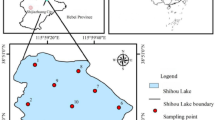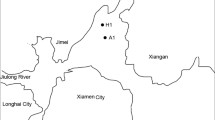Abstract
Network analysis has contributed to studies of the interactions of microorganisms and the identification of key populations. However, such analysis has rarely been conducted in the study of reservoir bacterioplankton communities. This study investigated the bacterioplankton community composition in the surface water of the Danjiangkou Reservoir using the Illumina MiSeq sequencing platform. We observed that the bacterioplankton community primarily consisted of 27 phyla and 336 genera, including Actinobacteria, Proteobacteria, and Bacteroidetes, demonstrating the richness of the community composition. Redundancy analysis of the bacterioplankton communities and environmental variables showed that the total nitrogen (TN), pH, chemical oxygen demand (COD), and permanganate index (CODMn) were important factors affecting the bacterioplankton distribution. Network analysis was performed using the relative abundances of bacterioplankton based on the phylogenetic molecular ecological network (pMEN) method. The connectivity of node i within modules (Zi), the connectivity of node i among modules (Pi), and the number of key bacteria were high at the Taizishan and Heijizui sites, which were associated with higher TN contents than at the other sites. Among the physicochemical properties of water, TN, ammonia nitrogen (NH4–N), pH, COD, and dissolved oxygen (DO) might have great influences on the functional units of the bacterial communities in bacterioplankton molecular networks. This study improves the understanding of the structure and function of bacterioplankton communities in the Danjiangkou Reservoir.







Similar content being viewed by others
References
Anders FA, Lasse R, Stefan B (2010) Pyrosequencing reveals contrasting seasonal dynamics of taxa within Baltic Sea bacterioplankton communities. ISME J 4:171–181
Bahram M, Harend H, Tedersoo L (2014) Network perspectives of ectomycorrhizal associations. Fungal Ecol 7:70–77
Banerjee S, Kirkby CA, Schmutter D, Bissett A, Kirkegaard JA, Richardson AE (2016) Network analysis reveals functional redundancy and keystone taxa amongst bacterial and fungal communities during organic matter decomposition in an arable soil. Soil Biol Biochem 97:188–198
Brown KS, Hill CC, Calero GA, Myers CR, Lee KH, Sethna JP, Cerione RA (2004) The statistical mechanics of complex signaling networks: nerve growth factor signaling. Phys Biol 1:184
Caporaso JG, Kuczynski J, Stombaugh J, Bittinger K, Bushman FD, Costello EK, Fierer N, Peña AG, Goodrich JK, Gordon JI, Huttley GA, Kelley ST, Knights D, Koenig JE, Ley RE, Lozupone CA, McDonald D, Muegge BD, Pirrung M, Reeder J, Sevinsky JR, Turnbaugh PJ, Walters WA, Widmann J, Yatsunenko T, Zaneveld J, Knight R (2010) QIIME allows analysis of high-throughput community sequencing data. Nat Methods 7:335–336
Chen P, Li L, Zhang H (2015) Spatio-temporal variations and source apportionment of water pollution in Danjiangkou Reservoir basin Central China. Water 7:2591
Chen ZJ, Zheng Y, Ding CY, Ren XM, Yuan J, Sun F, Li YY (2017) Integrated metagenomics and molecular ecological network analysis of bacterial community composition during the phytoremediation of cadmium-contaminated soils by bioenergy crops. Ecotoxicol Environ Saf 145:111–118
Chen Z, Yuan J, Sun F, Zhang F, Chen Y, Ding C, Shi J, Li Y, Yao L (2018) Planktonic fungal community structures and their relationship to water quality in the Danjiangkou Reservoir China. Sci Rep 8:10596
Chen M, He S, Li J, Hu W, Ma Y, Wu L, Ge G (2019) Co-occurrence patterns between bacterial and fungal communities in response to a vegetation gradient in a freshwater wetland. Can J Microbiol. https://doi.org/10.1139/cjm-2019-0147
Coyte KZ, Schluter J, Foster KR (2015) The ecology of the microbiome: networks, competition, and stability. Science 350:663–666
Creamer RE, Hannula SE, Leeuwen JPV, Stone D, Rutgers M, Schmelz RM, Ruiter PCd, Hendriksen NB, Bolger T, Bouffaud ML, Buee M, Carvalho F, Costa D, Dirilgen T, Francisco R, Griffiths BS, Griffiths R, Martin F, Silva PMd, Mendes S, Morais PV, Pereira C, Philippot L, Plassart P, Redecker D, Römbke J, Sousa JP, Wouterse M, Lemanceau P (2016) Ecological network analysis reveals the inter-connection between soil biodiversity and ecosystem function as affected by land use across Europe. Appl Soil Ecol 97:112–124
Dai WF, Zhang JJ, Tu QC, Deng Y, Qiu QF, Xiong JB (2017) Bacterioplankton assembly and interspecies interaction indicating increasing coastal eutrophication. Chemosphere 177:317–325
Deng Y, Jiang YH, Yang YF, He ZL, Luo F, Zhou JZ (2012) Molecular ecological network analyses. BMC Bioinformatics 13:113
Faust K, Raes J (2012) Microbial interactions: from networks to models. Nat Rev Microbiol 10:538–550
Faust K, Lahti L, Gonze D, de Vos WM, Raes J (2015) Metagenomics meets time series analysis: unravelling microbial community dynamics. Curr Opin Microbiol 25:56–66
Gao W, Chen Z, Li Y, Pan Y, Zhu J, Guo S, Hu L, Huang J (2018) Bioassessment of a drinking water reservoir using plankton: high throughput sequencing vs. traditional morphological method. Water 10:82
Guidi L, Chaffron S, Bittner L, Eveillard D, Larhlimi A, Roux S, Darzi Y, Audic S, Berline L, Brum J, Coelho LP, Espinoza JCI, Malviya S, Sunagawa S, Dimier C, Kandels-Lewis S, Picheral M, Poulain J, Searson S, Tara Oceans C, Stemmann L, Not F, Hingamp P, Speich S, Follows M, Karp-Boss L, Boss E, Ogata H, Pesant S, Weissenbach J, Wincker P, Acinas SG, Bork P, de Vargas C, Iudicone D, Sullivan MB, Raes J, Karsenti E, Bowler C, Gorsky G (2016) Plankton networks driving carbon export in the oligotrophic ocean. Nature 532:465–470
Guimerà R, Nunes Amaral LA (2005) Functional cartography of complex metabolic networks. Nature 433:895
Hanson CA, Fuhrman JA, Horner-Devine MC, Martiny JBH (2012) Beyond biogeographic patterns: processes shaping the microbial landscape. Nat Rev Microbiol. 10:497–506
Haukka K, Kolmonen E, Hyder R, Hietala J, Vakkilainen K, Kairesalo T, Haario H, Sivonen K (2006) Effect of nutrient loading on Bacterioplankton Community composition in lake mesocosms. Microb Ecol 51:137–146
Karimi B, Maron PA, Chemidlin-Prevost Boure N, Bernard N, Gilbert D, Ranjard L (2017) Microbial diversity and ecological networks as indicators of environmental quality. Environ Chem Lett 15:265–281
Lee CK, Barbier BA, Bottos EM, McDonald IR, Cary SC (2012) The inter-valley soil comparative survey: the ecology of dry valley edaphic microbial communities. ISME J 6:1046–1057
Li S, Gu S, Tan X, Zhang Q (2009) Water quality in the upper Han River basin, China: the impacts of land use/land cover in riparian buffer zone. J Hazard Mater 165:317–324
Li Z, Lu LH, Guo JS, Yang JX, Zhang JC, He B, Xu LL (2017) Responses of spatial-temporal dynamics of bacterioplankton community to large-scale reservoir operation: a case study in the Three Gorges Reservoir China. Sci Rep 7:42469
Liu LM, Yang J, Yu Z, Wilkinson DM (2015) The biogeography of abundant and rare bacterioplankton in the lakes and reservoirs of China. ISME J 9:2068–2077
Logue JB, Langenheder S, Andersson AF, Bertilsson S, Drakare S, Lanzén A, Lindström ES (2012) Freshwater bacterioplankton richness in oligotrophic lakes depends on nutrient availability rather than on species–area relationships. ISME J 6:1127–1136
Pan Y, Guo S, Li Y, Yin W, Qi P, Shi J, Hu L, Li B, Bi S, Zhu J (2018) Effects of water level increase on phytoplankton assemblages in a drinking water reservoir. Water 10:256
Peter H, Jeppesen E, De Meester L, Sommaruga R (2017) Changes in bacterioplankton community structure during early lake ontogeny resulting from the retreat of the Greenland Ice Sheet. ISME J 12:544
Sebastian J, Chandra AK, Kolattukudy PE (1987) Discovery of a cutinase-producing Pseudomonas sp. cohabiting with an apparently nitrogen-fixing Corynebacterium sp. in the phyllosphere. J Bacteriol 169:131–136
Segata N, Izard J, Waldron L, Gevers D, Miropolsky L, Garrett WS, Huttenhower C (2011) Metagenomic biomarker discovery and explanation. Genome Biol 12:1–18
Shen HL, Cai QH, Zhang M (2015) Spatial gradient and seasonal variation of trophic status in a large water supply reservoir for the South-to-North Water Diversion Project, China. J Freshwat Ecol 30:249–261
Shi S, Nuccio EE, Shi ZJ, He Z, Zhou J, Firestone MK (2016) The interconnected rhizosphere: High network complexity dominates rhizosphere assemblages. Ecol Lett 19:926–936
Stec KF, Caputi L, Buttigieg PL, D'Alelio D, Ibarbalz FM, Sullivan MB, Chaffron S, Bowler C, Ribera d'Alcalà M, Iudicone D (2017) Modelling plankton ecosystems in the meta-omics era. Are we ready? Mar Genomics 32:1–17
van Dijk EL, Auger H, Jaszczyszyn Y, Thermes C (2014) Ten years of next-generation sequencing technology. Trends Genet 30:418–426
Wang MC, Liu XQ, Zhang JH (2002) Evaluate method and classification standard on lake eutrophication. Environ Monit China 18:47–49 (in Chinese with English abstract)
Wang Y, Zhang R, Zheng Q, Deng Y, Van Nostrand JD, Zhou JZ, Jiao NZ (2016) Bacterioplankton community resilience to ocean acidification: evidence from microbial network analysis. ICES J Mar Sci 73:865–875
Wang H, Wei Z, Mei L, Gu J, Yin S, Faust K, Raes J, Deng Y, Wang Y, Shen Q, Yin S (2017) Combined use of network inference tools identifies ecologically meaningful bacterial associations in a paddy soil. Soil Biol Biochem 105:227–235
Xiong JB, Liu YQ, Lin XG, Zhang HY, Zeng J, Hou JZ, Yang YP, Yao TD, Knight R, Chu HY (2012) Geographic distance and pH drive bacterial distribution in alkaline lake sediments across Tibetan Plateau. Environ Microbiol 14:2457–2466
Xu H, Zhao D, Huang R, Cao X, Zeng J, Yu Z, Hooker KV, Hambright KD, Wu QL (2018) Contrasting network features between free-living and particle-attached bacterial communities in Taihu Lake. Microb Ecol 76:303–313
Zhao DY, Shen F, Zeng J, Huang R, Yu ZB, Wu QL (2016) Network analysis reveals seasonal variation of co-occurrence correlations between Cyanobacteria and other bacterioplankton. Sci Total Environ 573:817–825
Zhou JZ, Deng Y, Luo F, He ZL, Tu QC, Zhi XY (2010) Functional molecular ecological networks. MBio 1:1592–1601
Zhou JZ, Deng Y, Luo F, He ZL, Yang YF (2011) Phylogenetic molecular ecological network of soil microbial communities in response to elevated CO2. MBio 2:e00122
Zhou S, Zhang Y, Huang T, Liu Y, Fang K, Zhang C (2019) Microbial aerobic denitrification dominates nitrogen losses from reservoir ecosystem in the spring of Zhoucun reservoir. Sci Total Environ 651:998–1010
Acknowledgments
This research was supported by the National Natural Science Foundation of China (Grant Nos. 51879130, 41601332, and U1704124), the Key Scientific and Technological Project of Henan Province (Grant No. 172102110108), and the Key Research Project of Colleges and Universities of Henan Province Education Department (Grant Nos. 16A210012, 17A180032, 14B210015).
Author information
Authors and Affiliations
Contributions
Z-J C and Y-Y L designed the experiments and participated in writing the paper. Z-J C, GX, C-Y D and B-H Z performed the experiments and analyzed the data. Y C and H H conducted the field sampling. J-W S and L-Q H measured the water quality. All authors reviewed the manuscript.
Corresponding author
Ethics declarations
Conflict of interest
The authors declare that they have no competing interests.
Additional information
Communicated by Erko Stackebrandt.
Publisher's Note
Springer Nature remains neutral with regard to jurisdictional claims in published maps and institutional affiliations.
Zhao-Jin Chen and Ge Xu contributed equally to this work
Electronic supplementary material
Below is the link to the electronic supplementary material.
Rights and permissions
About this article
Cite this article
Chen, ZJ., Xu, G., Ding, CY. et al. Illumina MiSeq sequencing and network analysis the distribution and co-occurrence of bacterioplankton in Danjiangkou Reservoir, China. Arch Microbiol 202, 859–873 (2020). https://doi.org/10.1007/s00203-019-01798-7
Received:
Revised:
Accepted:
Published:
Issue Date:
DOI: https://doi.org/10.1007/s00203-019-01798-7




